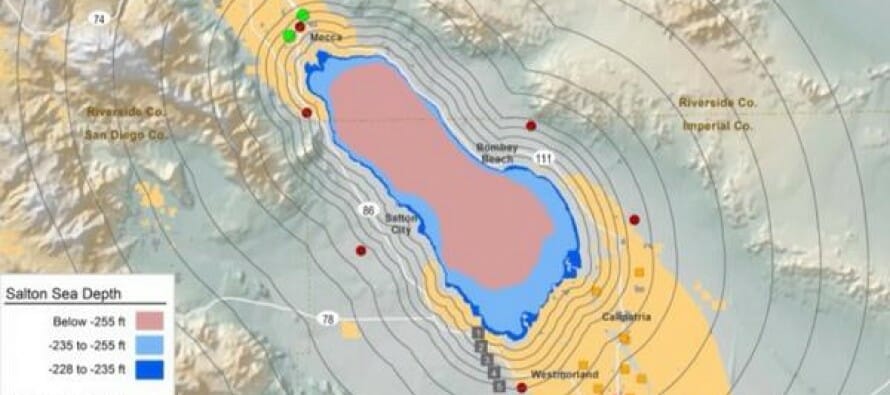New Report Warns of Massive Public Health as Salton Sea Declines

New Report Warns of Massive Public Health, Property, and Environmental Costs as Salton Sea Declines. Story Courtesy of the The Pacific Institute
September 3, 2014 – Oakland, Calif.: A new report released today by the Oakland-based Pacific Institute warns the shrinking Salton Sea will impose massive public health and environmental costs on local residents and Californians. The study quantifies, for the first time, the economic costs of the continuing failure to act at the Salton Sea.
The Salton Sea in context.“Worsening air quality and the loss of valuable habitat, combined with diminished recreational revenue and property devaluation, could cost Californians as much as $70 billion over the next 30 years,” said Michael J. Cohen, author of Hazard’s Toll: The Costs of Inaction at the Salton Sea. “Unfortunately, people had assumed that failing to take action at the Salton Sea would not impose any measurable costs. The new report describes how wrong that assumption really is,” Cohen said.
The Salton Sea is a 350 square mile saltwater lake in southeastern California. In the next fifteen years, the Imperial Valley-San Diego water transfer and several other factors will shrink the lake, exposing 100 square miles of dust-generating lake bottom to the region’s blowing winds, worsening the already poor air quality in the region. Ultimately, exposed lakebed may generate as much as 100 tons of dust per day. This fine, talcum powder-like dust gets trapped in people’s lungs, causing many health problems including asthma, heart disease, and lung cancer, imposing costs estimated at hundreds of millions of dollars each year.
Recent hydrogen sulfide eruptions from the Salton Sea – with their noxious rotten-egg smell – underscore the potential for the lake to depress local property values. The new report estimates that factors like hydrogen sulfide and blowing dust could depress property values in the region by $400 million or more. These factors, and the general decline of the lake itself, will also diminish recreational revenues.
“Even with conservative estimates, the long-term social and economic costs of a deteriorating Salton Sea could approach $29 billion,” said Cohen. “Failure to act imposes real costs on the 650,000 people living near the Salton Sea, and to a lesser extent on all Californians. These massive costs demonstrate the need for immediate action at the Salton Sea.”
Hazard’s Toll is a companion volume to Hazard: The Future of the Salton Sea With No Restoration Project. The previous volume contains information on the formation, ecological processes, and hydrology of the Salton Sea.
New Report Warns of Massive Public Health, Property, and Environmental Costs as Salton Sea Declines
Download the full report:
The Pacific Institute is dedicated to protecting the natural world, encouraging sustainable development, and improving global security. Founded in 1987 and based in downtown Oakland, the Institute provides independent research and policy analysis on issues at the intersection of development, environment, and security.
Related Articles
SPA RESORT CASINO TO HOST FIRST ANNUAL HOUSEKEEPING OLYMPICS
Coachella Valley Housekeeping Olympics In celebration of International Housekeepers Week, September 14 – 20, 2014, area housekeeping staff will compete in the first ever
Where Can You See a Bighorn Sheep, Porcupine and Hyena?
The Living Desert introduces its newest additions Now there is even more to explore at The Living Desert with the
The Old West Has Arrived in Banning…
The Old West Has Arrived in Banning…And it will be there through the weekend Fast-draw contests, steer roping and




